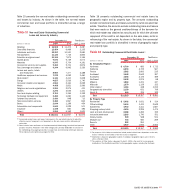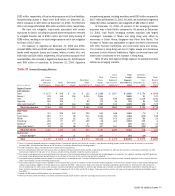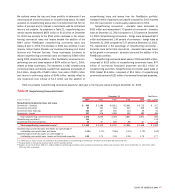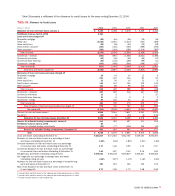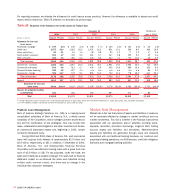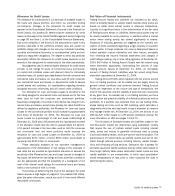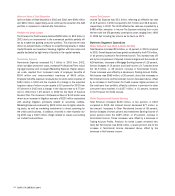Bank of America 2004 Annual Report Download - page 74
Download and view the complete annual report
Please find page 74 of the 2004 Bank of America annual report below. You can navigate through the pages in the report by either clicking on the pages listed below, or by using the keyword search tool below to find specific information within the annual report.
BANK OF AMERICA 2004 73
Our traditional banking loan and deposit products are nontrading
positions and are reported at amortized cost for assets or the amount
owed for liabilities (historical cost). While the accounting rules require
a historical cost view of traditional banking assets and liabilities,
these positions are still subject to changes in economic value based
on varying market conditions. Interest rate risk is the effect of
changes in the economic value of our loans and deposits, as well as
our other interest rate sensitive instruments, and is reflected in the
levels of future income and expense produced by these positions ver-
sus levels that would be generated by current levels of interest rates.
We seek to mitigate interest rate risk as part of the ALM process.
We seek to mitigate trading risk within our prescribed risk
appetite using hedging techniques. Trading positions are reported at
estimated market value with changes reflected in income. Trading
positions are subject to various risk factors, which include exposures
to interest rates and foreign exchange rates, as well as mortgage,
equity market, commodity and issuer credit risk factors. We seek to
mitigate these risk exposures by utilizing a variety of financial instru-
ments. The following discusses the key risk components along with
respective risk mitigation techniques.
Interest Rate Risk
Interest rate risk represents exposures we have to instruments
whose values vary with the level of interest rates. These instruments
include, but are not limited to, loans, debt securities, certain trading-
related assets and liabilities, deposits, borrowings and derivative
instruments. We seek to mitigate risks associated with the expo-
sures in a variety of ways that typically involve taking offsetting posi-
tions in cash or derivative markets. The cash and derivative
instruments allow us to seek to mitigate risks by reducing the effect
of movements in the level of interest rates, changes in the shape of
the yield curve as well as changes in interest rate volatility. Hedging
instruments used to mitigate these risks include related derivatives
such as options, futures, forwards and swaps.
Foreign Exchange Risk
Foreign exchange risk represents exposures we have to changes in
the values of current holdings and future cash flows denominated in
other currencies. The types of instruments exposed to this risk
include investments in foreign subsidiaries, foreign currency-denomi-
nated loans, foreign currency-denominated securities, future cash
flows in foreign currencies arising from foreign exchange transac-
tions, and various foreign exchange derivative instruments whose val-
ues fluctuate with changes in currency exchange rates or foreign
interest rates. Instruments used to mitigate this risk are foreign
exchange options, currency swaps, futures, forwards and deposits.
These instruments help insulate us against losses that may arise
due to volatile movements in foreign exchange rates or interest rates.
Mortgage Risk
Our exposure to mortgage risk takes several forms. First, we trade
and engage in market-making activities in a variety of mortgage
securities, including whole loans, pass-through certificates, commer-
cial mortgages, and collateralized mortgage obligations. Second, we
originate a variety of asset-backed securities, which involves the
accumulation of mortgage-related loans in anticipation of eventual
securitization. Third, we may hold positions in mortgage securities
and residential mortgage loans as part of the ALM portfolio. Fourth,
we create MSRs as part of our mortgage activities. See Notes 1 and
8 of the Consolidated Financial Statements for additional information
on MSRs. These activities generate market risk since these instru-
ments are sensitive to changes in the level of market interest rates,
changes in mortgage prepayments and interest rate volatility.
Options, futures, forwards, swaps, swaptions, U.S. Treasury securi-
ties and mortgage-backed securities are used to hedge mortgage risk
by seeking to mitigate the effects of changes in interest rates.
Equity Market Risk
Equity market risk arises from exposure to securities that represent an
ownership interest in a corporation in the form of common stock or other
equity-linked instruments. The instruments held that would lead to this
exposure include, but are not limited to, the following: common stock,
listed equity options (puts and calls), over-the-counter equity options,
equity total return swaps, equity index futures and convertible bonds. We
seek to mitigate the risk associated with these securities via hedging on
a portfolio or name basis that focuses on reducing volatility from
changes in stock prices. Instruments used for risk mitigation include
options, futures, swaps, convertible bonds and cash positions.
Commodity Risk
Commodity risk represents exposures we have to products traded in the
petroleum, natural gas, metals and power markets. Our principal expo-
sure to these markets emanates from customer-driven transactions.
These transactions consist primarily of futures, forwards, swaps and
options. We seek to mitigate exposure to the commodity markets with
instruments including, but not limited to, options, futures and swaps in
the same or similar commodity product, as well as cash positions.
Issuer Credit Risk
Our portfolio is exposed to issuer credit risk where the value of an
asset may be adversely impacted for various reasons directly related
to the issuer, such as management performance, financial leverage
or reduced demand for the issuer’s goods or services. Perceived
changes in the creditworthiness of a particular debtor or sector can
have significant effects on the replacement costs of both cash and
derivative positions. We seek to mitigate the impact of credit
spreads, credit migration and default risks on the market value of the
trading portfolio with the use of credit default swaps, and credit fixed
income and similar securities.


